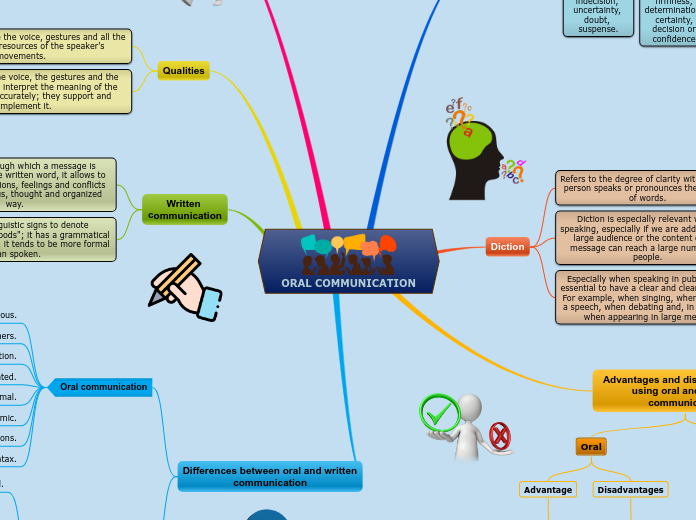STUDENT:
GONZALEZ O. LINDA G.
ID: 27.779.766
SYSTEMS ENGINEER
ENGLISH II
Ignorance of the language causes us to make many unforgivable mistakes. Therefore the good speaker and the good speaker must deepen the study and practice of orthology, which teaches us the correct pronunciation of words.
ORAL COMMUNICATION
Type in the name of the book you have read.
Differences between oral and written communication
Type the main events of the book, classifying them in: events from the beginning, events from the middle, and events from the end of the book.
Describe the story visually. Add a representative picture for each of them.
The syntax is taken care of; Is structured.
It must be precise and concise.
It becomes static or dynamic.
Language and form are selected.
Repetitions and redundancies are avoided.
We use signs.
Use idioms, sayings, others. only in literature.
It is more thoughtful and reasoned.
Type the main events from the middle.
Add a representative picture for each of them.
Oral communication
Break the syntax.
It is expanded with explanations.
It's dynamic.
It is almost always informal.
Words are repeated.
There is bodily action.
Use idioms, sayings, others.
It's spontaneous.
Type the main events from the beginning.
Add a representative picture for each of them.
Written communication
In contrast to the main idea, the theme is the message, lesson or moral of the book.
Some tips to find out the theme of the book easier:
- Try to find it while you are reading. It may be stated or implied.
- Think about how the characters reacted to obstacles.
- Think about the important decisions that the characters made.
- Think about the characters growing or changing throughout the book.
It only uses linguistic signs to denote "expressions" or "moods"; it has a grammatical structure; therefore, it tends to be more formal than spoken.
It is the one through which a message is emitted through the written word, it allows to express ideas, opinions, feelings and conflicts in a more conscious, thought and organized way.
Qualities
The intonation of the voice, the gestures and the movements help to interpret the meaning of the messages more accurately; they support and complement it.
Has the ability to use the voice, gestures and all the expressiveness resources of the speaker's movements.
Take notes while you read the book. Write here your favorite quotes from the book.
Definition
Take notes while you read the book. Type here the resources, books, or websites that the author mentioned and you want to check out later.
Refers to the speaking and listening skills necessary to participate verbally in discussions, exchange thoughts and information, make clear and convincing presentations, and interact with a variety of audiences.
It expresses both thoughts, ideas, slogans and, ultimately, any type of information or knowledge.
It is a form of communication typical of human beings in which they are transmitted orally, that is, spoken.
Advantages and disadvantages of using oral and written communication
Type the names of the book characters. Start with the main character.
Draw arrows to represent the relationship between them and if it is possible write on them what they represent for each other (if they are relatives, friends, lovers, enemies etc.)
Written
• Consumes more time.
• Lacks immediate feedback.
• There is no certainty of reception or interpretation.
• There is a permanent, tangible and verifiable record of communication.
• The content of the message is more rigorous and precise, logical and clear.
Oral
Disadvantages
• There is a high potential for distortion.
• The risk of personal interpretation is greater.
Advantage
What are the characteristics that best describe the character? Type them here.
• It is faster.
• There is feedback.
• Provides more information in less time.
Diction
What is the reason why the author wrote the book?
Especially when speaking in public, it is essential to have a clear and clean diction. For example, when singing, when making a speech, when debating and, in general, when appearing in large media.
Diction is especially relevant when speaking, especially if we are addressing a large audience or the content of our message can reach a large number of people.
Refers to the degree of clarity with which a person speaks or pronounces the sounds of words.
Intonation
Who is the author of the book? Type in his/her name.
The intonation can be:
The mixed is double, at the same time, ascending and descending, it can suggest a situation of conflict or a contradiction of the meanings and is frequently used to denote irony or sarcasm or to present a suggestion.
The descending one suggests firmness, determination, certainty, decision or confidence.
Ascending: suggests questioning, indecision, uncertainty, doubt, suspense.
Perceptual sensation basically caused by tonal variations (different combinations of lows and highs, lows and highs) that appear throughout a sentence
Intonation is the degree of elocution, inflection and expression of the voice achieved, to achieve a maximum quality oral expression.

